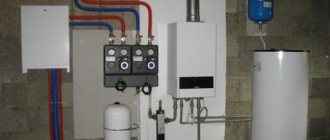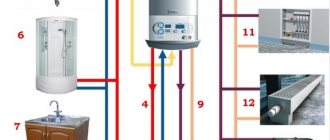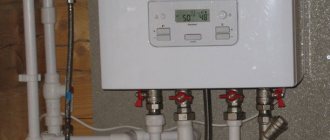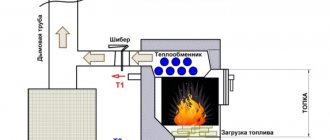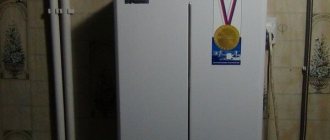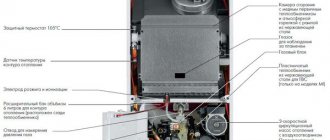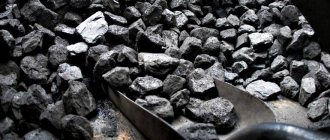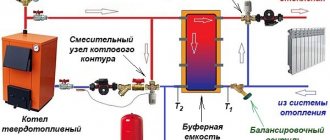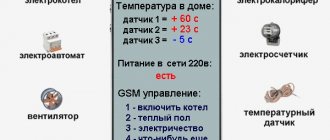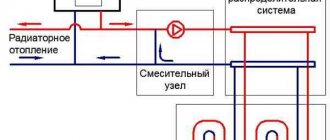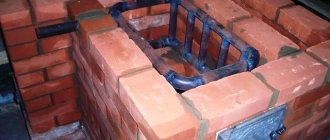Advantages
Convection boilers are less efficient than condensing models. Such units heat the coolant only due to the heat obtained from gas combustion. At the same time, approximately 20 percent of the energy is lost along with combustion products into the atmosphere.
But despite this, such boilers have a number of the following important advantages, which determine their popularity among consumers:
- One of the most significant advantages is the significantly low price compared to condensation, one and a half to two times.
- The installation method can be either wall or floor. It has a cast iron heat exchanger, which is one of the most reliable and will last a long time.
- a small amount of acid condensate, which is formed during the operation of the boiler, the bulk of which goes into the pipe along with the combustion products.
- Having an open combustion chamber, it uses ambient air for the combustion process, due to which the air in the room where the gas boiler is installed is cooled.
- easy installation, repair and dismantling.
- simple design.
- low noise level during operation.
- a wide selection of models, both single-circuit and double-circuit.
Single-circuit boilers
A single-circuit boiler is an installation that provides heating and preparation of the heating circuit coolant in accordance with the specified operating mode of the system.
The structure includes:
- Gas burner combined with a heat exchanger.
- Circulation pump.
- Turbofan.
- Gas equipment.
- Three way valve.
- Electronic control board equipped with a self-diagnosis sensor system.
- Housing, control panel.
- Chimney.
There are non-volatile models that do not have devices powered from the mains.
They have a simplified design, but are capable of heating a home in the absence of power.
Types of single-circuit boilers
Single-circuit boilers are:
- Floor-standing. Installed directly on the floor (or on a stand). They can have a lot of weight and, accordingly, high power. Many floor-standing boilers are equipped with a cast iron heat exchanger of increased efficiency and heavy weight. Some models are connected in a cascade, forming powerful connections for heating buildings or structures of large area and volume.
- Wall-mounted. Compact gas boilers that are mounted on solid (preferably load-bearing) walls. The specifics of the installation require a weight limit, which automatically affects the power of the boilers.
In addition, single-circuit boilers can have different combustion chamber options:
- Atmospheric (open). The air comes directly from the room, and the smoke is removed naturally under the influence of stove-type draft.
- Turbocharged (closed). Air is taken in from the outside using a turbofan. It also creates pressure that displaces smoke and other gases formed during fuel combustion.
All single-circuit boilers can have additional functions - remote control, programming of operating modes, etc.
Principle of operation
The operation of a single-circuit boiler is aimed at solving a single task - heating the coolant for the heating circuit.
The unit is connected to a gap in the system, one pipe is connected to the direct line, the second to the return line. The liquid flow continuously moves through a heat exchanger, which is located in the heating zone of the gas burner flame.
At the outlet of the heat exchanger, the flow enters a three-way valve, where it is mixed in a given proportion with the colder flow from the return. Having received the required temperature, the coolant is again discharged into the heating circuit.
The temperature is adjusted by adjusting the operation of the three-way valve.
Advantages and disadvantages
The advantages of single-circuit boilers include:
- Simplicity and reliability of design.
- No power loss during heat transfer.
- Ability to develop greater power.
- Possibility of connecting an external indirect heating boiler to produce hot water.
- The cost of single-circuit boilers is lower than that of more functional models.
The disadvantages of single-circuit boilers should be considered:
- Lack of water heating function.
- Limited capabilities compared to dual-circuit models.
Features of work
What is a convection boiler? It is a traditional device with an open, or less often closed, combustion chamber, consisting of one heat exchanger, a gas burner and automation that regulates the gas supply. When the gas has entered the system, using piezo ignition or electric ignition (depending on the model), the pilot burner is ignited, burning constantly.
It ignites the main burner, heating the coolant to the temperature set by the thermostat. After this, the automation turns off the main burner. When the temperature drops, the thermocouple is triggered and the valve opens, allowing gas to flow. Such processes occur cyclically in the boiler.
Convection units are divided into single-circuit, which are intended only for heating; heating water requires the installation of additional equipment, and double-circuit. The latter are intended for both heating and hot water. In the summer, the heating mode is turned off, the boiler is used only as a water heater.
When fuel burns, steam is generated, which is discharged through the chimney. The chimney must be made of materials that are resistant to corrosion, and that is why it should not be made of brick, which is not resistant to aggressive environments. Such a chimney must be lined with either stainless steel or acid-resistant tiles.
The boiler chimney is made of steel
When installing the unit, it is necessary to design the heating system taking into account that the outlet temperature of the combustion products is from 58 degrees. This requirement is necessary to ensure that aggressive condensate does not form on the surfaces of the combustion chamber, heat exchanger and chimney, which destroys the surfaces of these devices and leads to failure of the unit itself.
But it is precisely because of this condition that a significant part of the power is lost, about 20 percent of it flies into the chimney. If you decide to install a convection gas boiler, then you must understand that some of your money will evaporate into the air.
Gas boiler chimney
If the chimney is made according to all the rules, then a lot of condensation should not form on its walls. However, all chimney elements must be made of acid-resistant materials. Brick is not such, so brick chimneys quickly fail. They must be lined with a liner made of stainless steel or special acid-resistant ceramics.
Boilers with closed fireboxes are most often equipped with a coaxial pipe (pipe in pipe). As already mentioned, boilers with a power of up to 30 kW can be connected to a pipe that passes through the wall. But for more powerful boilers, you will need to install a vertical coaxial chimney, which will cost twice as much as a regular stainless steel liner.
Structural differences between gas convectors and boilers
A convector is a device for heating one separate room; it does not require the installation of radiator heating pipes throughout the room. Outwardly it resembles an electric fireplace or radiator, only larger. Inside it there is a burner in a closed combustion chamber, into which air enters, thanks to which the gas is burned and exhaust gas products are removed.
When fuel burns, the combustion chamber is heated, which warms the surrounding air using a fan installed inside the convector. When installing such a device, a gas supply and a coaxial chimney are required to each unit. It can operate on both main and liquefied gas, i.e. from the cylinder.
The use of a convector heater is limited, taking into account the disadvantages of such a device:
- a large number of pipes and holes punched for them, necessary for the installation of each convector,
Gas convector - the decrease in room temperature is directly proportional to the distance from the device, low inertia. As a result, rapid heating and equally rapid cooling occurs, and this has a detrimental effect on both the interior decoration of the premises and the furniture in them.
Based on the foregoing, we can conclude that it is better to install such devices in garages, warehouses, and industrial premises, where it is not necessary to maintain a constant temperature.
The main structural difference between a boiler and a convector is the presence of a heat exchanger and the need to distribute radiator pipes throughout the room, with the help of which the room is heated evenly and for a long time. The waste products are removed through the chimney if the boiler has an open combustion chamber. A double-circuit boiler provides both room heating and the need for hot water.
Comparison with a condensing boiler
When operating condensing equipment, the water in the return circuit must be cooled as much as possible in order for condensation to form. Drops fall from combustion products that are saturated with vapor. The coolant receives additional energy and increases the temperature before entering the boiler heat exchanger.
Condensation models have additional chambers for heat exchange and condensation, called economizers. The compartments are made of metal that is difficult to corrode, since the walls are in contact with liquid. In convection units, heat is obtained only from gas combustion, and heat from condensation is not used.
Condensing units produce 20% more heat than traditional models when burning the same volume of fuel. The efficiency of equipment of the first type reaches 95 - 100%, and convection types show 82 - 86%.
Condensing boilers require a special pipeline design to cool the energy carrier to a low temperature. Massive and expensive radiators are used, and if the liquid is not cooled, the system with the unit will operate with an efficiency lower than that stated in the passport. The equipment is not available with open fireboxes.
Comparison of convection and condenser boilers
The condensing unit uses not only the energy released when gas is burned, but also the heat that is generated when steam is formed in the gas combustion products. Structurally, it differs from convection in the presence of another additional heat exchanger - an economizer, installed at the outlet of waste gas products. In fact, it is primary, since after heating it, the coolant enters the main heat exchanger.
Condensing boiler design
To form condensate, it is necessary to achieve cooling of the steam that is formed as a result of gas combustion products below the dew point - 56 degrees when using main gas. The need to supply cooled return water allows you to expand the heating system, for example, you can make heated floors, which cannot be done with a convection boiler.
The need to obtain a lower temperature at the outlet requires the installation of radiators with increased heat transfer, for example, aluminum and bimetallic, which are quite expensive. It will be impossible to achieve efficient operation with cast iron batteries.
In conventional boilers, the temperature of the combustion products is quite high and therefore condensation practically does not form. Energy is partially wasted, but the parts of the unit and the chimney itself are not exposed to aggressive influence.
A condensing boiler is available only with a closed combustion chamber, in contrast to a convection boiler, which can be either closed or open, depending on the model. A closed chamber is the safest. It is equipped with a fan, with the help of which air enters the firebox; excess pressure itself pushes the exhaust gases through the coaxial channel.
Thus, combustion products do not enter the room where the boiler operates. If the boiler has a power of less than 30 kW, the duct can be installed in the wall; with a higher power it must be mounted above the roof level.
The chimney is on the roof
Additional heat is the key to high efficiency (more than 100 percent) of condensing boilers. Despite the high cost compared to convection devices, approximately twice as high, such devices are more efficient, have an efficiency one and a half times higher than convection devices due to reduced gas consumption and pay for themselves within 3 years. The high cost of such boilers is due to the use of stainless steel materials, resistant to aggressive environments, and technologies that allow it to be welded.
Differences in spending and calculations
The technical characteristics of the product are indicated by the manufacturer in the passport; for boilers they are as follows: efficiency of convection boilers - 90-93%, condensing - up to 110%, the difference is purely arithmetic no more than 20%. Comparison of figures is not in favor of the latter, since their cost is several times higher. A more detailed analysis should be carried out taking into account site-specific factors and calculation methods.
European data indicate a payback for condensing models within five years; for domestic consumers the time frame is different due to the low cost of fuel, the weak distribution of low-temperature types of heating with heated floors and multi-section radiators of increased area.
Therefore, potential savings should be calculated in advance. A house insulated according to building codes loses 1 kW\hour per 10 sq. meters. For a house of 100 sq. m. in central Russia, 240 kW will be required to replenish daily heat losses. For the convenience of calculations, the accepted fuel is natural gas, the specific heat of combustion of which is 10 kW per cubic meter, and 1 kW of the boiler will require 0.1 cubic meter. m. of its combustion in the furnace.
A convection boiler (efficiency - 90%) will require 240 kW * 0.1 cubic meters. m.*1.07(90%) = 26 cubic meters. m per day.
At a price of 5 rubles/m³, daily expenses will be 128 rubles.
For condensing, the calculations will be as follows: 240 kW * 0.1 cubic meters. m.*0.91(110%) = 22 cubic meters. m per day.
The cost of gas is 109 rubles per day. Daily estimated savings – 20 rubles per day.
But do not forget that there are also regions with much more expensive gas and there are houses with a much larger area.
Efficiency used in calculations differ from the passport ones prescribed by the manufacturers. This is explained by the specifics of calculating the calorie content of fossil fuels. There are two terms: “higher” and “lower” fuel combustion heat. Initially, it was believed that the energy consumption for moisture evaporation and condensation formation is insignificant, and they can be neglected in calculations. Therefore, the characteristics of thermal systems were calculated based on “lower” indicators. As the value of this share of costs became more precise, figures for the “higher” fuel heat of combustion began to be used, which led to values exceeding one hundred percent. From a physical point of view, this is impossible, because the amount of energy obtained during combustion cannot be greater than that stored in the composition of chemical bonds, but traditionally established methods have not been changed, which has led to an efficiency indicator of 110 percent.
Draft and removal of combustion products when using convection boilers
They use natural traction to operate. This is a process when, due to a pressure difference, a flow of cold air enters the room, and warm air is forced out. This is driven by the difference in height between the air inlet and outlet.
Installation of chimneys from gas appliances
When the boiler operates, combustion products are produced that have an elevated temperature - about +180°C. They must be removed through a special chimney located in the upper part of the wall of the room or in the roof.
Cooler air must continuously flow into the room. It is necessary to replenish the part already used for gas combustion.
If this is not done, gas convection boilers will not work. They will be turned off by special automatic traction control. The possibility of combustion products (carbon monoxide) entering the room cannot be ruled out. This can happen in an emergency when such automation fails. The consequences are simply life-threatening.
Therefore, natural ventilation of the room is a necessary condition for the operation of convection boilers. With its proper design and operation, efficient combustion of natural gas and safety of users will be ensured.
